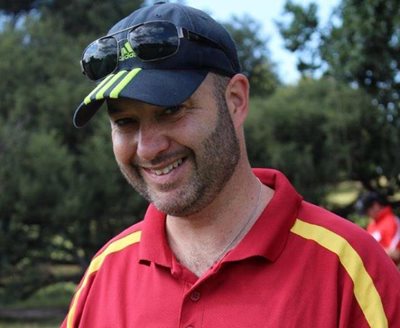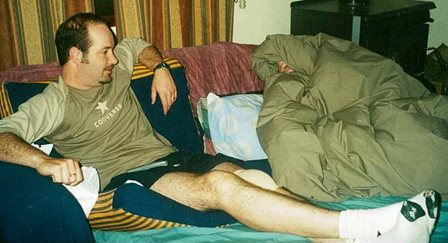SUZANNE O'CALLAGHAN
Suzanne O’Callaghan is HFA Policy Research and Education Manager
A fairly common comment over the last few years has been that with prophylaxis and home therapy, people with bleeding disorders no longer need to spend so much time in hospital – but that, ironically, this means there are fewer opportunities for them to connect for peer education and support.
This makes local Foundation activities like community camps and retreats and the men and women’s breakfasts and other peer support groups an immensely precious time together and HFA works hard to find funding to support them.
The needs of men around early ageing is a new and challenging area for HFA. Our intensive work on The Female Factors, the women and girls project, has given a real insight into the education and peer support needs of women and girls in our community and the education resources and activities evolving out of this are very exciting. However, HFA’s long experience of working with men in the community has shown that a different approach is required for men, and we also know that there is much more work that needs to be done to understand and respond to the issues around early ageing.
Advances in haemophilia treatment and care over the last few decades have meant that there has been overall increase in life expectancy for people with haemophilia, and many are now living into their senior years.(1)

Photo: Jason
Jason, now 44 years old, has mild haemophilia and recalls the very different story he was told when he was first diagnosed as a teenager:
“The doctor said my life expectancy was 30. So when you've got a kid who's 13 and is told they might only live to 30, how daunting is that!”
Growing older with haemophilia has raised another set of issues. Men with haemophilia who are now in their mid-20s or older lived through a time when prophylaxis was not yet available and there were treatment shortages at times. Most now have haemophilia-related arthritis from repeated bleeding into joints. They also experienced the hepatitis C and HIV epidemics in the bleeding disorders community in the 1980s, where many acquired bloodborne viruses from infected clotting factor concentrates.
As a result, issues of ageing, such as mobility and pain problems relating to arthritis, occur at a much earlier age in this generation of men with haemophilia – in general at around 35-40 years, although it can be at a younger age if they have had many bleeding episodes, particularly if they have had inhibitors and their treatment has not been effective. (1,2,3)
Even with mild haemophilia, and not having as many bleeding episodes as someone with moderate or severe haemophilia, Jason hasn’t escaped without some complications.
“Now at the age of 44, I have some osteoarthritis in my right knee. My condition has absolutely had an effect on my life, and I do have to take care of myself more than others. I still keep active, training with the local over 35s football team, riding my bike and running on nice soft grass to keep my joints in order.”
He also acquired hepatitis C, he suspects from a blood product he received when he was 13.
“I was diagnosed with hepatitis C in 2005 after a routine medical check. In the 1980s, most people with bleeding disorders were exposed to hepatitis C virus before it had been ‘discovered’. I underwent treatment and I am now hepatitis C free.”
HFA’s community consultations have highlighted that the Australian bleeding disorders community has a culture of stoicism and resilience. As one man with haemophilia said, “you learn to live with haemophilia. You’re born with it, you grow up with it.”
In spite of the good news that lifespans for many have increased, it is a community that remains aware of its vulnerability; that, for example, a head injury or a bloodborne virus like HIV or hepatitis C might tragically cut short a life.
The pain of bleeds and arthritis, the complications of bloodborne viruses if they have them, and limitations of their haemophilia can be challenging and make it hard to maintain a positive approach to their life. (4,5)
Jason comments,
“I still train with the over 35s masters football, but it's really frustrating. I train really well on the track, and people ask why I don’t play, but I know my limitations. I still have to be careful what I do, and the difficult thing is the pain. People don’t understand that if I get a bleed it will knock me around for a week or two.”

Photo: Jason recovering from a bleed
Apart from the mental fatigue of constantly fighting their physical problems, these men can become overwhelmed by the number of health conditions they have and the appointments and procedures required.
As one man with severe haemophilia in his 30s said to HFA,
“If you ask about the perfect consultation, I think these haemophiliacs, they’re like sports cars. They need to come into the pitt lane. We get the arthritis, we get the hep C, we get the HIV, and those when they combine, create a mental health issue. And also there’s counselling you need if you are in work. You are going to need some support to stay there. You need someone to help you get out of bed in the morning sometimes. You need rails in your bathroom. Other times you need other things.” (5)
As they grow older, they face the same other health conditions associated with ageing in the general population: cancer, heart disease, kidney disease, mental health problems and lifestyle issues such as weight control and muscle development. These are usually managed by a general practitioner and will create another set of medical appointments for this generation of men. How can this be made more manageable for them?
HFA is starting new work to better understand the issues of early ageing in men with haemophilia and potential benefits of a “men’s health” approach.
What opportunities are there to help men with haemophilia to support each other and maintain a resilient and positive approach to life?
And what kind of information and resources would be helpful for these men about their health and wellbeing – and how would it be best to deliver it?
The very successful men’s peer support groups in some local Foundations show how valuable it can be to have a face-to-face relaxed environment for men to chat together about ordinary things like sport and cars, while at the same time sharing strategies for managing their health and learning about relevant health issues and services. But with mobility and distance issues, travel and meeting can be difficult. What other potential is there for connecting and peer support? Are there other ways that would suit this generation of men to come together? For example, online forums, phone or video or email networking, a virtual “men’s shed”?
These are just some of the questions we are aiming to answer.
Hannah Opeskin, HFA Health Promotion Officer, will be leading the work on this project. Contact Hannah for more information:
T: 03 9885 7800 (Mon-Wed)
E: hopeskin@haemophilia.org.au
1.Hermans C, de Moerloose P, Dolan G. Clinical management of older persons with haemophilia. Critical Reviews in Oncology/Hematology 2014;89(2):197-206. doi: 10.1016/j.critrevonc.2013.07.005.
2. Canaro M, Goranova-Marinova V, Berntorp E. The ageing patient with haemophilia. European Journal of Haematology. 2015;94 (Suppl 77):17-22. doi: 10.1111/ejh.12497.
3. Australian Haemophilia Centre Directors’ Organisation (AHCDO). Guidelines for the management of haemophilia in Australia. Canberra: National Blood Authority, July 2016.
4.Haemophilia Foundation Australia. “A double whammy”: living with a bleeding disorder and hepatitis C. Melbourne: HFA, 2007.
5. Haemophilia Foundation Australia. Getting it right: hepatitis C needs assessment evaluation and implementation report. HFA: Melbourne, 2009.
Haemophilia Foundation Australia acknowledges the Traditional Owners and Custodians of Country throughout Australia, the land, waters and community where we walk, live, meet and work. We pay our respects to Elders past and present and extend that respect to all Aboriginal and Torres Strait Islander peoples.
Sign up for the latest news, events and our free National Haemophilia magazine